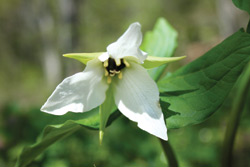If you're hunting for cancer-fighting substances, there's no need to journey to the Amazon in search of some rare plant dangling in the upper reaches of the jungle canopy. The Bent Creek Institute here in Asheville and its partners at Wake Forest University have discovered a dozen plant species that are “cytotoxic to breast and/or prostate cancer cells in culture,” the BCI Bulletin reported last fall. In collaboration with Western Carolina University chemistry professor Jack Summers, the institute is also preparing its first patent application for a naturally occurring anti-oxidant, superoxide dismutase, that appears to help fight cancer, infectious diseases and inflammation.

Meanwhile, a clinical trial comparing the benefits of combining anti-oxidants and radiation therapy is about to get under way at Mission Hospital, in cooperation with Wake Forest's Comprehensive Cancer Center, says Jeff Schmitt, Bent Creek's research director.
On top of that, Southern Appalachian forests may contain their own version of the cancer-fighting compound Taxol , found in the Pacific yew tree. Scientists are investigating the medicinal properties of the spruce fir, including an endophyte that grows within the high-elevation species' upper reaches, says Joe-Ann McCoy, who directs the ever-expanding BCI Germplasm Repository. (Endophytes are plants or fungi that live inside other plants.)
All these developments are part of the plants-to-people pipeline the institute is charged with developing, Executive Director Cheryl McMurry explains. “We've had people here for eons using and making medicinal, plant-based remedies, but other than Gaia Herbs, there's never been a productive industry built around it,” she continues. The Brevard-based Gaia employs about 100 people and sells its products across the country. Nationwide, the industry generated an estimated $85 billion in sales in the U.S. in 2006, according to the Natural Products Association.
Utah currently claims the lion's share of that business: It's home to the natural-supplement giant Nature's Way, McMurry notes. “Yet nothing grows there: They import all their products. Why not create an industry right here?”
That's no idle suggestion, as Bent Creek has been proving since opening its doors nearly three years ago with a $120,000 grant from the University of North Carolina. She and Schmitt have leveraged that startup money to generate $2 million worth of funding and partnerships. In the current economic climate, some of that state money is at risk, McMurry concedes, but she still maintains, “I want to see Western North Carolina take its place beside the eastern part of the state for science.”
The biotechnology industry's many aspects — research, new crops for farmers, manufacturers, distributors and more — present a huge market opportunity that's too valuable to let slip away, Schmitt asserts.
McMurry says this twist on the green-jobs industry starts with the plants.
All the developments noted above began with the idea that many species either native to Western North Carolina or able to grow here show much promise as medicinals. To better study plants such as beth root (a kind of trillium), black cohosh, ginseng and self-heal , the institute maintains a seed bank. Among the more than 500 plants are 22 black cohosh (Actaea racemosa L.) varieties, all nine echinacea species, and a collection of Chinese medicinals.
The germplasm project is a crucial starting point. Scientists need specimens collected under rigorous guidelines; rare or endangered species need to be conserved; and viable cultivars can be developed from collected plants that can be grown in WNC, McCoy explains. “We're concentrating on medicinal plants but also on endangered habitats,” she notes. The Southern Appalachians have the highest percentage of spruce fir populations in North America, but they're at the limits of their range and vulnerable to changing conditions. Should climate change spur rising temperatures, for instance, “It has nowhere to go,” says McCoy.
She also points out that companies like Gaia would rather buy domestic plants than import them: Echinacea from China is often contaminated by heavy metals, and studies show that the plant's effectiveness varies greatly depending on where and how it's grown, McCoy reveals. (The institute, incidentally, partnered with Clemson University and Gaia to develop the technology for analyzing heavy-metal concentrations in plants.)
Meanwhile, scientists have recently learned that endophytes appear to share many of the qualities of their hosts, notes McCoy. Saint John's wort produces an anti-viral agent that could fight HIV and influenza; the accompanying endophyte might share those properties and thus be quite useful in developing medicines, she explains.
With endophytes as with the Bent Creek Institute, it seems, a little collaboration can go a long way.
Send your environmental news to mvwilliams@mountainx.com or call 251-1333 ext. 152.



CORRECTION: Nature’s WAY is the Utah-based company we were referring to, not Nature’s GATE, which is in California.